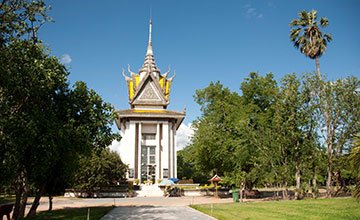
The Tuol Sleng Genocide Museum
The Tuol Sleng Genocide Museum is a museum in Phnom Penh, the capital of Cambodia. The site is a former high school which was used as the notorious Security Prison 21 (S-21) by the Khmer Rouge regime from its rise to power in 1975 to its fall in 1979

Killing Fields of Cheung Ek
Killing Fields of Cheung Ek is situated 15 kilometers south-west of Phnom Penh and made famous by the film of the same name "Killing Field". It was a place where more than 17,000 civilians were killed and buried in mass graves

The Ounalom Pagoda Phnom Penh
The origin of the Ounalom Pagoda can be traced to as far back as the 15th Century. It was built in 1422 by King Ponyea Yat, the last king of the Khmer empire. It is one of the five original monasteries in Phnom Penh that King Ponhea Yat had built, the pagoda founded

Wat Phnom
The temple has a strong connection with establishment of the capital city of Cambodia. The current name of the city Phnom-Penh in native language means literally the hill of Ms. Penh. According to a legend, a woman named Penh found a lot of little statues of Buddha in the river

The Independence Monument
The Independence Monument (Vimean Ekareach) is situated at the cross of the Sihanouk and the Norodom Boulevards in the center of Phnom Penh. It was built in 1958 to commemorate the country's victory against the French regime

The National Museum of Cambodia
The history of the National Museum of Cambodia goes back to the early 20th century. It was inaugurated on 13 April 1920 under the patronage of King Sisowath and the French Resident Francois Baudoin, and was named Musee Albert Sarraut after

The Royal Palace of Cambodia
The Royal Palace of Cambodia is a complex of buildings along with numerous other interesting buildings within the 183,135 square meters (421m x 435m) compound is The Khemarin Palace, also known as Prasat Khemarin or the "Palace of the Khmer King

